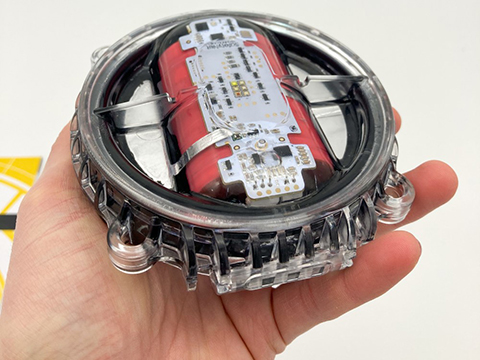
Posted to News on 7th Feb 2024, 13:00
Potting compound selection for LED assembly
Depending on an application's needs, there are numerous potting compounds available, with formulations offering properties including being low density/lightweight, flame retardant, flexible, optically clear, and thermally conductive. It can be challenging to know which material to specify, given the different chemistries, properties, and processing requirements. Kevin Brownsill, head of technical: learning and development at Intertronics, shares insight on potting compound selection for an LED assembly.

LED applications exist in automotive engineering, indoor and outdoor lighting, marine lighting, signage, infrastructure, architecture and interior design, and more. Manufacturers may need to protect these electronic assemblies from dust, debris, moisture, pressure, impact, vibration, and chemicals.
With environmental protection, there are two main options seal them into an enclosure with a lens, or pot them with resin. LEDs generate heat as well as light, and so there are often requirements for thermal management of LED PCB assemblies. Potting the non-optical side of the assembly with a thermally conductive potting compound can help with this.
The level of protection required from potting depends on the final environment the product will function in. For example, underwater swimming pool lights must be fully waterproof to IP68, as well as have good resistance to chlorine and other chemicals. Companies that supply into military assemblies, such as lighting for war ships, should consider Mil-SPEC testing of physical characteristics relating to operational durability, ruggedness, and reliability. If the potting compound is being designed into a medical device, the designer will need to consider meeting ISO 10993.
Choosing a material
After establishing environmental protection level required and determining the industry's testing regime, the design engineer can begin to narrow down an appropriate chemistry. This involves considering many factors, including the desired harness, resistance to yellowing, clarity, thermal conductivity, cost, and processing methods.
For products where the LED must be seen, designers typically specify an optically clear coating on the front of the product. On the rear of the device, this is less important and designers may consider a different material that offers the desired thermal management characteristics. For LED assemblies that require a clear finish, there are three main chemistries, polyurethanes (PUs), epoxies, and silicones, which each bring advantages and disadvantages.
Polyurethane potting compounds
We typically recommend that customers test polyurethane materials first, due to their versatility, hardness, reasonable price, and UV resistance. These two-part materials cure at room temperature and their 1:1 mix ratio means they are easy to handle and use. PUs are available in various packaging styles, from small to large two-part cartridges, twin-packs, and bulk containers. They have good long-term UV resistance, and can be formulated with anti-UV additives that avoid yellowing, making them popular for outdoor applications.
Many of our customers start by trialling Opti-tec 4200, a clear polyurethane resin. Available in double syringe or twin-pack sachets, the material is easy to mix and apply and cures to a clear, scratch resistant finish. It is also available as Opti-tec 4220, a semi-opaque, milky-white version that provides an aesthetically pleasing finish by allowing a high transmission of light, while hiding underlying electronics.
One drawback of PUs is that they are hygroscopic and are therefore sensitive to moisture before cure PUs readily absorb moisture from the air, which reacts to form a gas and can cause bubbling in the material. To avoid this, the material must be kept dry during storage and application.
One recent example of a polyurethane potting application is our project with sustainable fishing start-up SNTech. The company's flagship product is a sophisticated kit of ten LED lights that fits onto fishing gear to enable more precise fishing. SNTech was developing a pressure-resistant version of the device for deep sea fishing (suitable for being submerged up to 1,000 metres) and required a potting compound.
Because light colour and intensity were important to the device's functionality, we recommended Opti-tec 4210, an optically clear potting compound for the top of the device, and IRS 3071, a more cost-effective but non-optically clear potting compound for the bottom of the device.
Epoxy potting compounds
Epoxies are a cost-effective option that offer high temperature and chemical resistance and perform well in salt water or mineral/oil-based environments. These materials are hard-wearing and environmentally resistant, and are used in automotive and marine applications. One key drawback is that epoxies are prone to yellowing due to the bisphenol in the resin they are therefore selected where yellowing is not an important factor.
Epoxies are often used for smaller applications, as their exotherm during cure in larger volumes can lead to a loss in clarity. Their 2:1 mix ratio makes them easy to handle, and they are available both in twin-packs and bulk. A typical starting point to trial would be Opti-tec 5020, a material designed for applications where optical clarity, good wetting, and low viscosity are important. It is available in both black and clear versions, which could be considered for both the front and back of a device.
Silicone potting compounds
Silicones offer good clarity, are suitable for potting large areas, and are relatively soft when cured. They are available in gel formulations, where they retain a jelly-like consistency even post cure, which can be advantageous for products in environments that are subject to extreme shock, temperature or thermal cycling. This softness can be a disadvantage too an additional lens may be needed as the product may not be hard enough to form a lens itself, and as they are soft and susceptible to abrasion.
Silicones are UV resistant and tend not to discolour, while offering good temperature resistance of up to 200C. We would typically recommend that our customers start by trying Wacker RT 601 or 604. RT 601 is a highly transparent, low viscosity material that offers medium cured hardness, whereas 604, is a softer material.
Silicone potting materials are easy to handle and apply. Cure times are usually long (a day or two). While the curing process can be accelerated with heat, too high a temperature can impact the material's clarity, and it is a careful balance.
One example comes from our work with a manufacturer of outdoor signage and lighting products. The customer was looking to encapsulate its LED strips to protect them from weather and other external factors, but was experiencing quality issues with the materials they were testing, such as delamination. This was aesthetically unacceptable as it altered the colour temperature of the light output and posed the potential for functional failure.
Intertronics recommended the customer evaluate Wacker Silgel 612, which provided good adhesion, optical clarity, and is waterproof. Its gel-like texture means it can absorb shock or vibration, protecting the electronic circuits from damage and thermal cycling.
Processing requirements
When specifying a potting compound for an LED assembly, considering the packaging the material will be supplied in can help to build a straightforward and cost-effective process. For low volume applications, a cartridge or twin-pack might be most suitable, whereas in high-volume applications, bulk containers are typically more efficient. PUs are the most flexible chemistry in terms of the packaging, and they are static mix, which makes them a good option to trial for smaller runs or R&D projects.
The materials used for potting LEDs are typically two-part, meaning they must be both mixed correctly and dispensed accurately. Available process options range from manually mixing and dispensing from a twin-pack, dispensing from a cartridge through a static mixing nozzle, right through to metering, mixing, and dispensing equipment, fed from bulk containers.
Epoxies and silicones typically only come in twin-packs and bulk, and many manufacturers find success with a 2-K-DOS metering, mixing, and dispensing system. For applications requiring the highest accuracy, a preeflow eco-DUO precision metering, mixing and dispensing system offers accuracy of 1%, >99% of the time. This system can be combined with a robot that delivers positional accuracy.
Considering the processing requirements early can help to deliver better return on investment. It may be more cost effective to invest in a preliminary technology, and then add to it later. An experienced materials and equipment provider can recommend suitable material and processing equipment for the manual or automatic dispensing of potting compounds.





